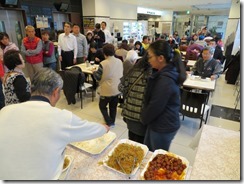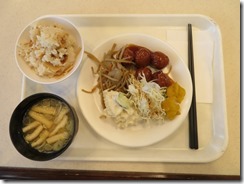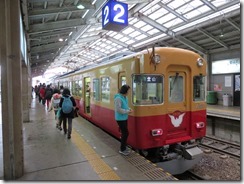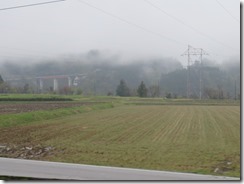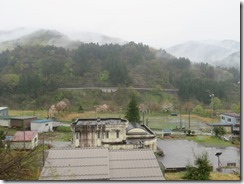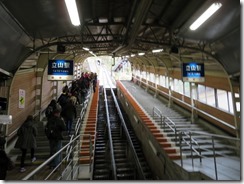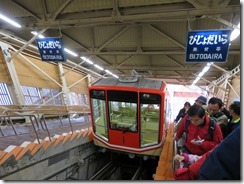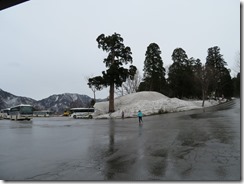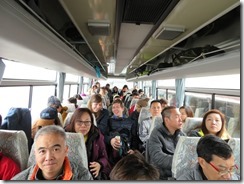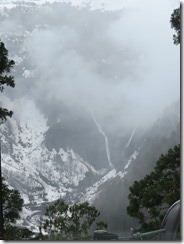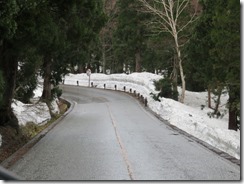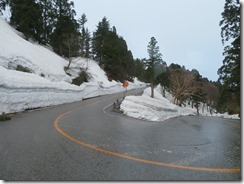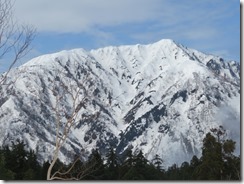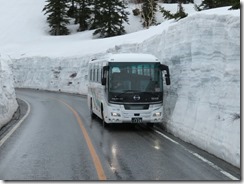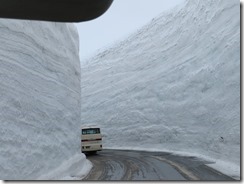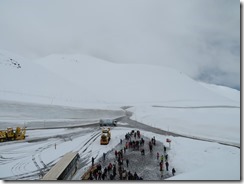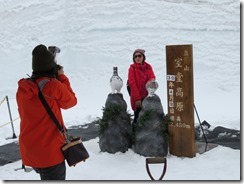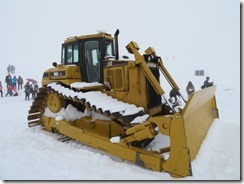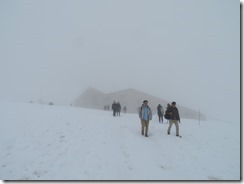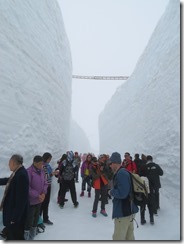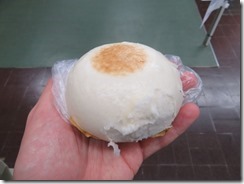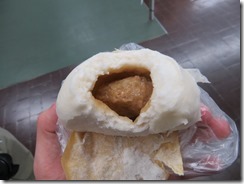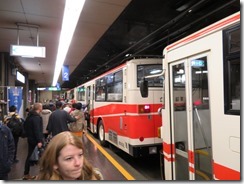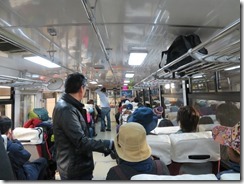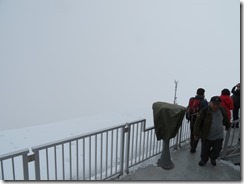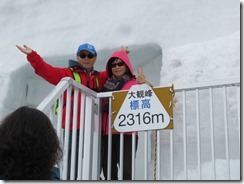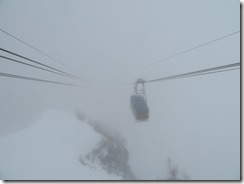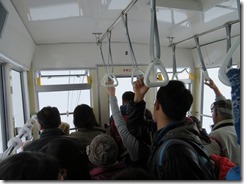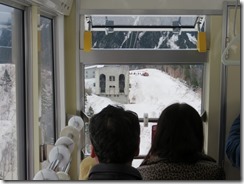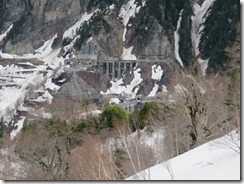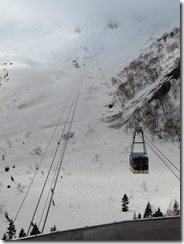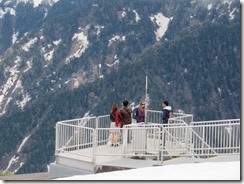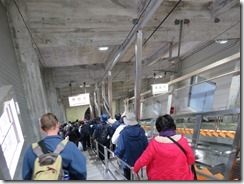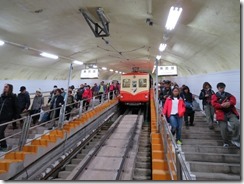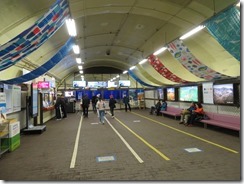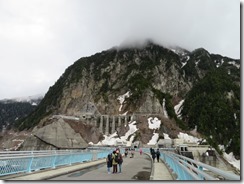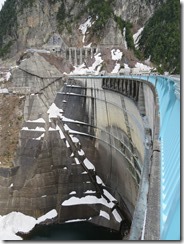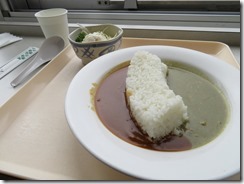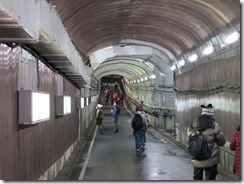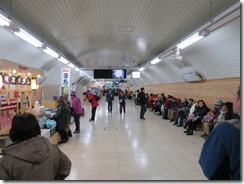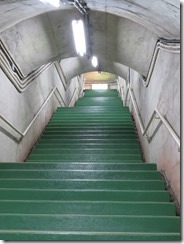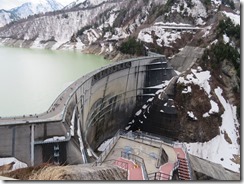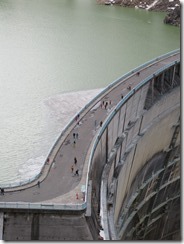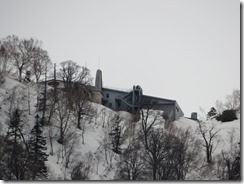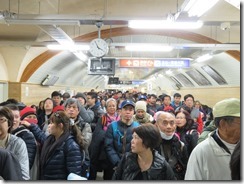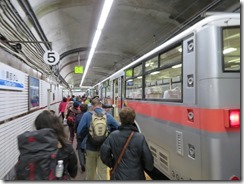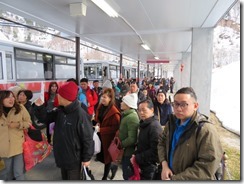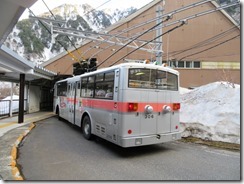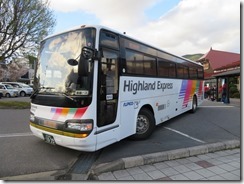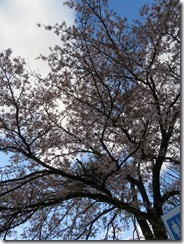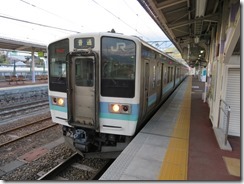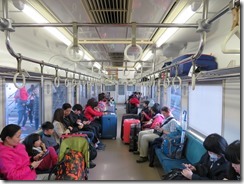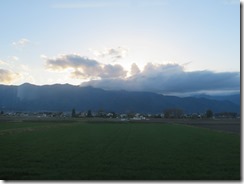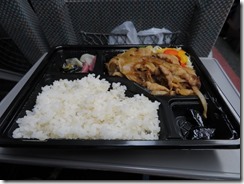One admittedly minor peeve I’ve noticed is that although on my last trip, the assistance of my external battery let my phone’s battery last throughout the day, on this trip, my external battery seems to run out around mid afternoon, meaning I need to ration my phone use in order to make it back to the hotel. I can’t figure out whether I’m doing something different, or whether is just that both my phone and my external battery are just that little bit older, and so hold just a little bit less charge…
Today, we woke up too early, and headed down for breakfast at 7, and found the breakfast room completely packed with people. This rather seems like the popular time to be coming to breakfast. Also, as promised, the weather was all dreary and rainy. Not driving rain, fortunately.
Why the early start? Today we planned to travel over the Tateyama-Kurobe Alpine Route, a journey over (and in some cases through) the northern Japanese Alps from Tateyama, a small town near Toyama, to Omachi, a city in Nagano Prefecture near Matsumoto. The route consists of taking seven different forms of public transport, with five different modes. The entire route is just 37km long, but involves an elevation change of almost 2km.
Possibly the main draw card for me was the “Snow Walls” – walls of snow up to twenty metres high from where they’ve excavated the roadway so that buses can drive on it, and you’re able to walk between them for about five hundred metres. Today was one of the first days it had been reopened to the public after the winter shutdown, so I was hoping it’d be particularly spectacular. (For those wondering whether that much snow would last into the spring, the answer is absolutely yes – the snow around that area lasts until the summer.)
Since the route did only just reopen this week, though, it’s also the peakiest of peak periods for visitors. I’d hoped that going during the week would lessen the load, and perhaps it did, but every website I consulted in my research warned that it’d be busy for the entire remainder of the month, with long waits for some forms of transport. So I’ve been doing calculations as to exactly how late we could afford to catch each leg of the journey and still make the connection to our next hotel before the trains stopped for the night, and found that we had about four to six hours of leeway, depending on how early we could get started. Just as my big day after leaving Yunomine Onsen was the main source of stress for my last trip, today was the main source of stress for this one.
Which finally brings us back to why we were having breakfast at 7am: to get the earliest train we could manage without getting so little sleep that we’d be zombies all day. Most of our breakfast companions were suits – which is perhaps not entirely surprising, since they needed to eat in time to get to work – but from their outfits, more than a few people in the room were also planning to do the Alpine Route.
Immediately after breakfast, we finished packing and brought our luggage downstairs. Since lugging your suitcase over a mountain range does not sound like much fun, standard practice for the Alpine Route is to get your baggage shipped separately, and fortunately our hotel is one of a number of hotels in Toyama which allow you to ship directly from the hotel (rather than from the station). We bought the shipping tags from the hotel, and added our suitcases to the rather large collection of similarly-tagged suitcases, and headed off.
We’d already purchased our tickets in the form of a single combo ticket the day before – weirdly, it’s sold by JR, even though not a single leg of the Alpine Route involves any JR property. A friend of mine is planning to do this same journey in a couple of weeks, and she introduced me to this deal. It’s actually cheaper than buying the Alpine Route trips individually, but it also includes the connections back to the train lines at each end, so it’s quite a bargain. They need to be bought by the day before you want to use them at the latest, though.
So our first trip – the zeroth leg of the Alpine Route, I suppose – was the private line Toyama Chiho Railway from Dentetsu-Toyama Station (adjacent to the JR Toyama Station). We managed to turn up in time for the express train to Tateyama (though that requires a small extra surcharge), and they exchanged our JR ticket for the pass that we’d be using for the rest of the day (which also includes a start time for the first actual leg of the route). The train quickly left Toyama and started to head into the mountains, soon arriving at Tateyama Station.
Our tickets wouldn’t let us board the next leg for about forty minutes after arriving, so we had a short wander around the immediate area, though it was still drizzling, but soon, our time came to board.
Segment number one: the Tateyama Cable Car from Tateyama to Bijodaira. Which, in apparent contradiction to the name, is a funicular railway. They use the words differently in Japan, basically. The car was actually quite packed, and I wound up trapped in the middle, unable to take any photos. Not a bad view, though, as we climbed higher and higher, then at the top, we entered into a tunnel.
And after we’d disembarked and emerged from the station, snow! Snow everywhere! I mean, except falling from the sky. Actually, it was still trying to drizzle. We looked around for a little bit, then went to queue for our next segment. While lining up, though, I spotted a sign “Snow Walls closed today”. Disaster! And also, there were a few short walks in the area that I was vaguely hoping to try out, but there was another sign up saying they wouldn’t open until the end of May. Bah.
Anyway, segment number two: Bus from Bijodaira to Murodo. Specifically, the Tateyama Highland Bus. James and I managed to score the front seats, so we had a good view out the front window, though they also had a tourist information DVD playing on the bus’ TV. Not too long after leaving Bijodaira, the bus stopped at a corner with quite a nice view of Shomyo Falls, Japan’s highest waterfall.
“But wait,” you say. “Didn’t you say that about Nachi Falls?” Well, no – I said Nachi was Japan’s highest single waterfall. Shomyo has a total drop of 350 metres, but over four stages of 70m, 58m, 96m and 126m. It’s also adjacent to Hanoki Falls, which is 497 metres high, but since it only flows from April to July, when the snow on the Midagahara Plateau melts, that means it doesn’t count, for some reason.
I’d hoped to see the Shomyo Falls up close – there’s a bus there from Tateyama Station – but I wasn’t sure we’d have the time for it, so being able to see it from this bus was a nice treat. After that, the bus continued on, and as it did so, the walls of snow alongside the road grew higher and higher, until they were seventeen metres tall – about the height of a six-storey building, and then we were at Murodo, the highest point on the journey, with an altitude of 2450 metres.
Murodo is where the Snow Walls are, and sadly, as per the sign in Bijodaira, they were closed to pedestrians. It was never clear to me exactly why it was closed, but I had a feeling it’s because having it open reduces the bus roadway to only one lane, and they required both lanes to support the volume of visitor traffic.
On the plus side, though, the rain had stopped. On the downside, however, fog quickly rolled in, turning everything a completely uniform white – snow below and fog above. Without sunnies on, it was absolutely blindingly bright, but even with sunnies on, my pupils were so contracted I could not read my camera or phone screens at all. James and I thought to explore a little bit down some walking paths, but even though the paths were lined with rope handrails, with everything so uniformly white, we weren’t really willing to move out of sight of the station.
Continuing the game of good news bad news, though, there was fortunately a miniature pedestrian-only version of the Snow Walls that we could walk down and admire, and it was pretty interesting. Looking up close at the snow, you could see layers of ice. Also, it actually wasn’t all that cold. It was supposed to be about 3°C, but I felt heat on my head and arms like the sun was beating down on me, even though I couldn’t see it at all.
After sightseeing around there for a bit, we each bought a steamed meat bun for morning tea, then went to queue for the next form of transport.
Segment number three: the Tateyama Tunnel Trolley Bus. One of only two trolley buses still operating in Japan, this runs entirely underground through a tunnel under what my visitors’ guide map calls “Mount Tateyama”, but which all the various audio guides called something else I never quite caught the name of. It’s in a tunnel both to protect the environment from the bus, but also to protect the bus from the environment – specifically, from all the snow. And so because it’s in a tunnel, it’s a trolley bus, because it produces no emissions. Since a trolley bus is legally classified as a type of train in Japan, this makes Murodo the highest-altitude train station in Japan. (It also includes Japan’s highest hot spring, but we didn’t get a chance to see it.)
James and I were right up the back for this leg, and the seats were surprisingly comfortable for a bus. The buses drove together in convoy – probably because it speeds up loading at each end – and most of the tunnel is one-lane, save for a section in the middle where buses can pass.
At the other end of the tunnel, we emerged blinking into the sun at Daikanbo, in a small station perched on the side of a steep mountain. It had a three-tier lookout deck, but sadly, all there was to see was white. Lots and lots of white. With nothing else to do there but buy coffee, we decided to move on.
Segment number four: the Tateyama Ropeway. This is what we in Australia would call a cable car, or what Americans would call an aerial tramway. From the top station, all there was to see, though, was two sets of cables abruptly disappearing into the fog, when suddenly, one appeared.
I call this artwork “Gondolas in the Mist”. Now where’s Dian Fossey? In any case, we piled aboard. I found myself pressed against the door, but I got a spectacular view. It’s actually the longest unsupported ropeway in Japan. Pretty soon after we set out, we dropped below the clouds, and could finally see views of the mountains all around.
Arriving in Kurobedaira, we headed outside to the “Garden” – really just a patch of more snow to tromp around in – for a bit of looking out, then we headed up to the roof of the building for a better vantage point. James even launched his drone to make a panorama. It was quite curious watching the cable car cables just vanishing into the clouds, like Jack’s beanstalk, or something.
Segment number five: the Kurobe Cable Car. Another funicular, though this one running entirely through a tunnel, which descended down into the Kurobe Gorge, stopping at Kurobeko – Lake Kurobe. To get outside from the funicular, we had to walk down a longish tunnel and in contrast to how warm it was hanging out in the snow, that tunnel was certainly cold. At the end of the tunnel was…
Segment number six: walking. Specifically, walking across the Kurobe Dam, the tallest dam in Japan. Construction on the dam started in 1956 as a solution for a lack of electric power in the Kansai region of Japan, today it’s regarded as “the most popular hydropower site in Japan”, though I wonder if its position on the Alpine Route might have something to do with that. From May onwards, they frequently release water from the spillway for the enjoyment of onlookers.
We strolled over the dam, and decided to stop at the rest house on the other side for lunch. We both got varieties of the rest house’s specialty – Kurobe Dam curry. To be specific, it’s Japanese-style curry rice, but with the rice formed into the shape of the Kurobe Dam. I had the two-curry dish, with red and green curry, and the rice was holding them apart. It was, I confess, a little spicier than I expected Japanese curry to be, so I got a hot can of royal milk tea (basically just tea with milk and sugar) from the vending machine to soothe my mouth a bit.
After lunch, we still had plenty of time left until we had to catch the next leg, so we strolled up to the upper observation deck. Or to be more precise, we clambered up the two hundred and twenty-odd steps. Impressive view from the top, though.
Once we got back to the bottom, I realised to some surprise that the next departure time was the last one before the final one we could take, so we hurriedly joined the queue. Not at all sure what happened to all that extra time we had.
Segment number seven: the Kanden Tunnel Trolley Bus, the other of Japan’s two remaining trolley buses. This was built by the Kansai Electric Power Company to assist in the construction of the dam, and they constructed (and still own) the trolley bus once it was done (since the tunnel proved not up to the task of being opened as a public road for cars). Since, as mentioned before, trolley buses are legally considered railways, this ironically makes the Kansai Electric Power Company the railway operator in the country with the largest capital stock.
But anyway, the trolley bus is again almost entirely underground, crossing from Toyama Prefecture to Nagano prefecture shortly after the middle of the tunnel, before emerging to the surface just before the lower terminal at Ogizawa. We hopped off the trolley bus, and pretty much straight on the regular old local bus which was our connection to the nearest railway station, and soon we were back below the snow line and back in civilisation.
It was a fun trip, all in all, despite the lack of side activities I’d been hoping to do, and the lack of view in some of the higher stops. If I do it again, it might be worth staying in Tateyama so I can start a bit earlier, or even splitting it into two days, staying at the hotel at Murodo in the middle. Though many of our rides were quite crowded, the long wait times prophesied by various sources fortunately failed to eventuate. The rain let up too, which was also nice. I did get a bit sunburnt, though, or probably snowburnt.
In any case, the bus dropped us at Shinano-Omachi Station, where we (fortunately) found our luggage waiting for us. And a cherry tree in full bloom right next door. We headed into the station and hopped onto an Oito Line local train for Matsumoto. At Matsumoto, we booked seats on the Shinano Express for Nagano, then tried to find some dinner.
On our last visit here, we picked up some ekiben from a shop at this station, except I wound up with some kind of sushi thing instead of an actual bento, so I kinda wanted to try again, especially when I saw a picture of the new Matsumoto specialty ekiben. However, it took us forever to find the shop – I couldn’t remember where it was – until two non-Japanese women told us it was inside the ticket gates. So we rushed off there… and discovered they were sold out of every single bento box they had.
So we wound up going back to another shop we’d seen earlier offering fresh bentos, and we both ordered yakiniku – grilled meat – boxes. They came with quite a lot of rice, but seemed to be a little stingy on other sides. Oh well, they were quite tasty all the same. By the time we received them, though, we basically had to rush for the train, but we made it just in time.
For the third time, I’ve now gotten off a train in Nagoya, and for the second time, I’ve actually left the station. Now on this trip, for the first time, I’m actually staying here. Our next hotel is here in Nagoya – and unlike in Toyama where we missed the opening of a new hotel by mere days, in Nagoya we’re staying in one of the newest hotels in the chain, having opened just last month in March. But also unlike Toyama, where the new hotel is just across from the station, this hotel is about a kilometre away, which is not great. It’s quite palatial, though – it’s like an actual grand hotel, with an entrance driveway and multiple banks of elevators and so forth. And as I’d expected, it uses my member card to open our room door (though James was given his own generic card key as well).
Tragically, I think I might have left my pen sitting on the reception desk in our Toyama hotel, after I used it to fill out my luggage forwarding tag…
Welp, time for bed now. Since it’s just about midnight, photos will have to wait. Possibly even two nights – we’ve got a plan for tomorrow night as well, but that may be cancelled depending on how we’re going. Three late nights in a row might be a bit much.
Today’s photo count: Six hundred and fifty-five
Today’s step count: 13,230 steps, for 9km exactly
Today’s goshuin count: I was vaguely hoping to find some kind of temple or shrine on the route – Shinto has frequently involved mountain worship, and supposedly along with Mount Fuji and Mount Haku (in Gifu), Tateyama is regarded as one of Japan’s three holy mountains. But there wasn’t any kind of temple or shrine. Sooo… no goshuin.
Today’s stamp count: Oh, boy was today a busy day for stamps. The Alpine Route visitor’s guide has spaces for stamps, one at each station, and I discovered they also have larger versions for people’s stamp books, so I stamped the small one on the guide, and the big one in the book. Trouble is, I clean forgot Murodo’s until after we left, and we couldn’t find Ogizawa’s anywhere, and had to get on the bus right then or be stuck there another half-hour. We also found a separate series of ten stamps around the Kurobe dam, but we only found seven of those ten, which I stamped three to a page (as they’re quite small). I also got stamps from Shinano-Omachi Station and Matsumoto Station, though clean forgot that Dentetsu-Toyama Station might have a different stamp to the JR Toyama Station. So in total, nine big ones, seven small ones, and five ones in the visitor’s guide. Whew.

